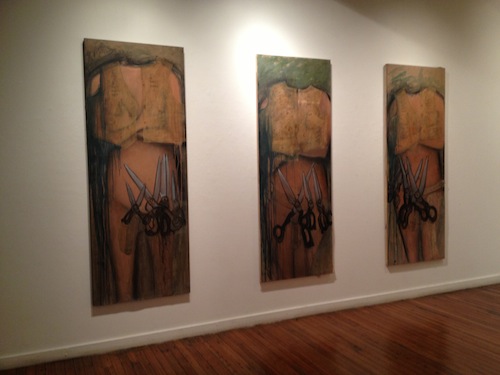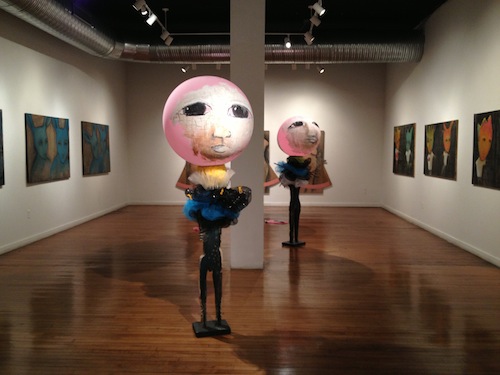According to Merriam-Webster, transfiguration is a metamorphosis, a change in appearance. From a Catholic perspective, the term can also signify a spiritual change, with a specific Christian feast to celebrate the ‘transfiguration’ of Christ, where he appeared to three disciples on a mountaintop, usually the Sunday before Lent. For artist Lania D’Agostino, the term is the underlying theme that connects several different bodies of work, including paintings, drawings, assemblage, and sculpture, all currently on display in the solo exhibit, Transfigurations, at School 33 Art Center.
First of all, it is incredibly rare to find an artist whose day job involves creating plaster cast figures for museums and movies. The artist’s expertise in this age-old and currently-untrendy-at-art-school process is immediately evident: the specificity of D’Agostino’s plaster sculptures demand your attention as soon as you enter the gallery. Headless and stark white like Greco-Roman statues, D’Agostino’s figures couldn’t be more opposite their idealized ancestors. You can stare all day at the delicate ripples in the skin and sagging musculature. These details bear witness to their origins from less-than-perfect and older bodies.
The life-sized figures are arranged in duos and trios, and gallery text reveals that the forms, which range from male to female, were cast from the same body: before, during, and after the process of a sex change. This information is a game changer. Suddenly the artist’s drawings, paintings, and balloon figures, which originally seemed like playful cartoons, take on a more serious message: are they purposely genderless or are they in transition? Or are they the faces of individuals who are confused or ambivalent about gender roles? Many of D’Agostino’s paintings depict multiple figures: big-eyed jackrabbits and confused looking orange faces, while others portray nude figures with scissors floating around their nether regions and nude hermaphrodites wearing ballet tutus.
Compared with the plaster sculptures, D’Agostino’s paintings and assemblages seem farcical and loose, almost silly, especially the life-size assemblage figures of gauze and fabric, where actual balloons are drawn on as the faces that must be replaced when the heads deflate or pop. Several remnants of ‘former’ heads are left as evidence on the gallery floor, attesting to this process. Despite the humor and a lightness in their creation, D’Agostino’s characters do not appear to be comfortable, and many feature X’s and hash mark patterns on their skin, as if engaged in a tribal ritual or scarification. They meet your eyes with comically large beseeching eyes, as if asking for help, or at least understanding. Taken as a whole, the works in Transfigurations provide a window into another world where commonly held assumptions about gender identity, the basic categories we divide ourselves into, are a luxurious illusion. For those of us who were born into bodies that feel rightly ours, this show is a reminder that transfiguration is not a choice.
 Lovely trays of goodies for those who arrive early! Yum.
Lovely trays of goodies for those who arrive early! Yum.
*Author Cara Ober is a Baltimore-based artist and the Editor of Bmoreart.















